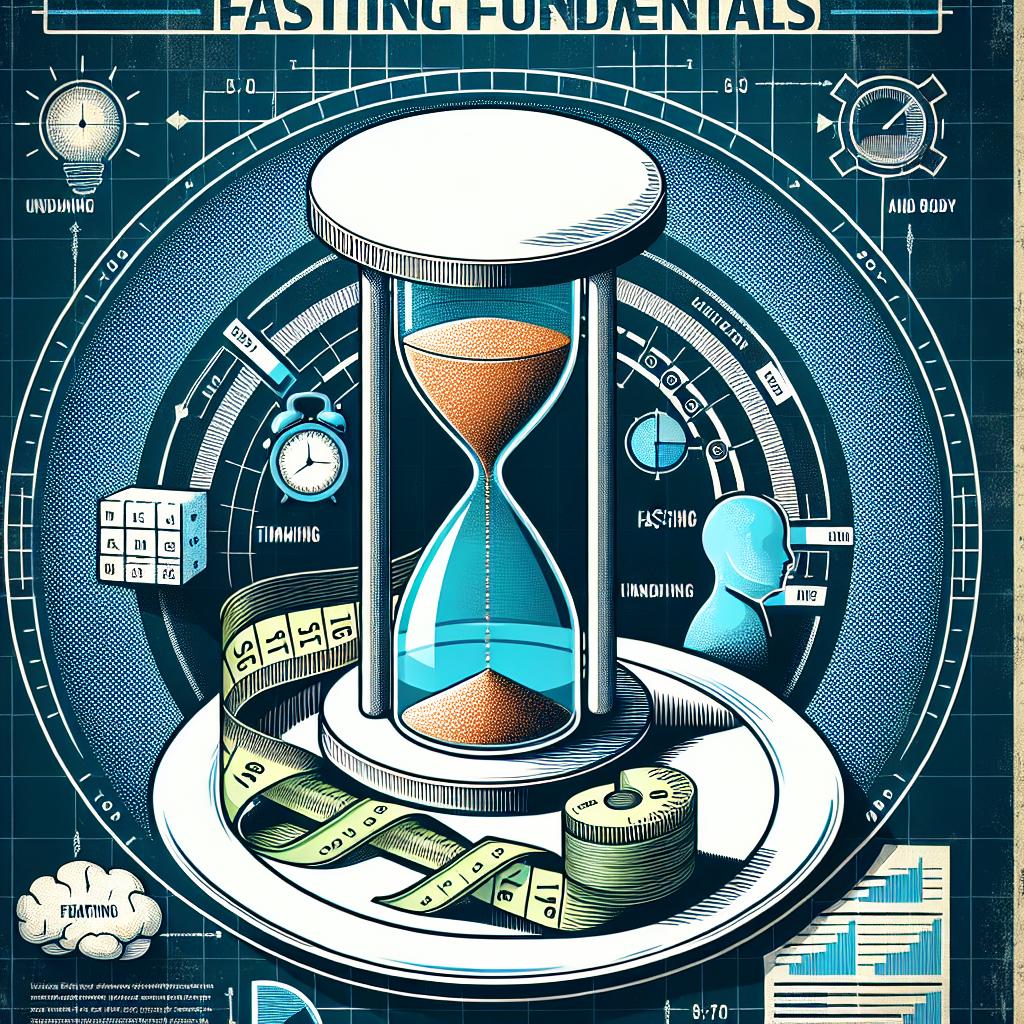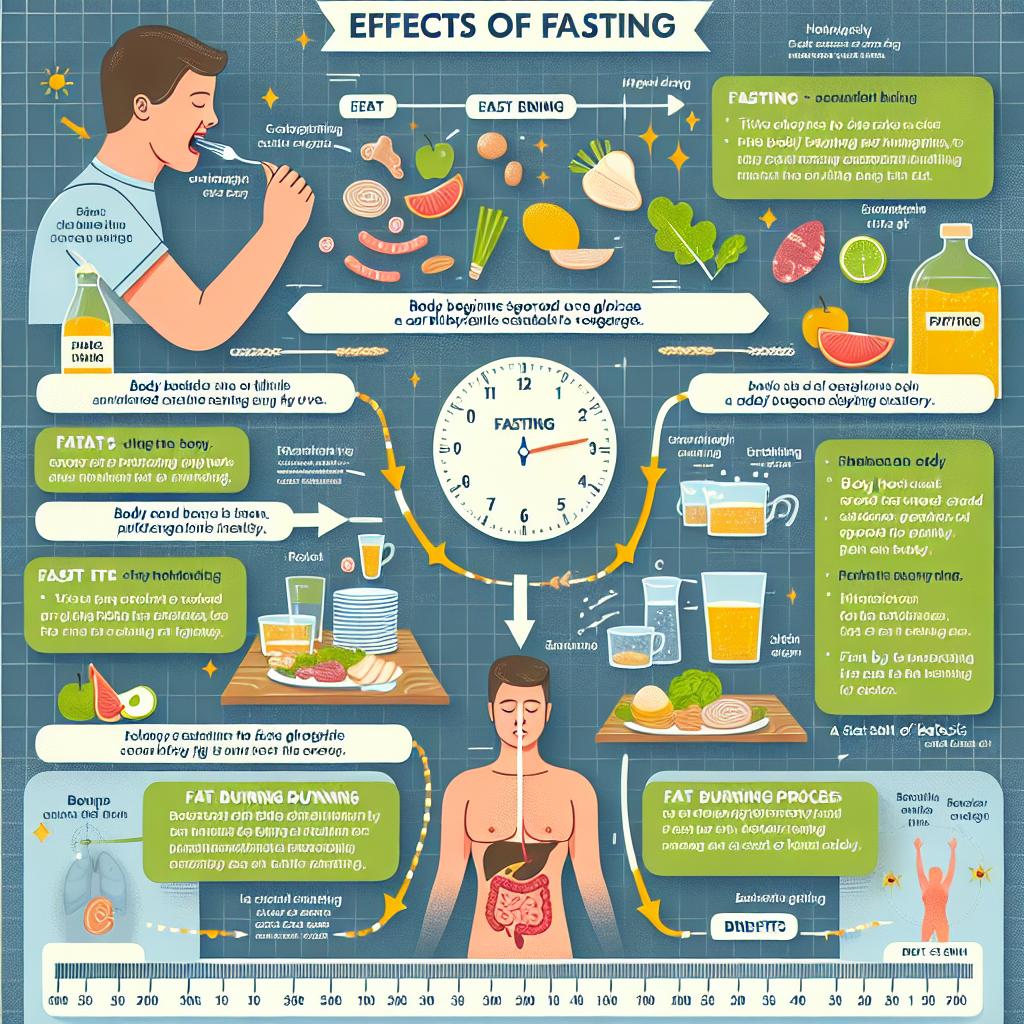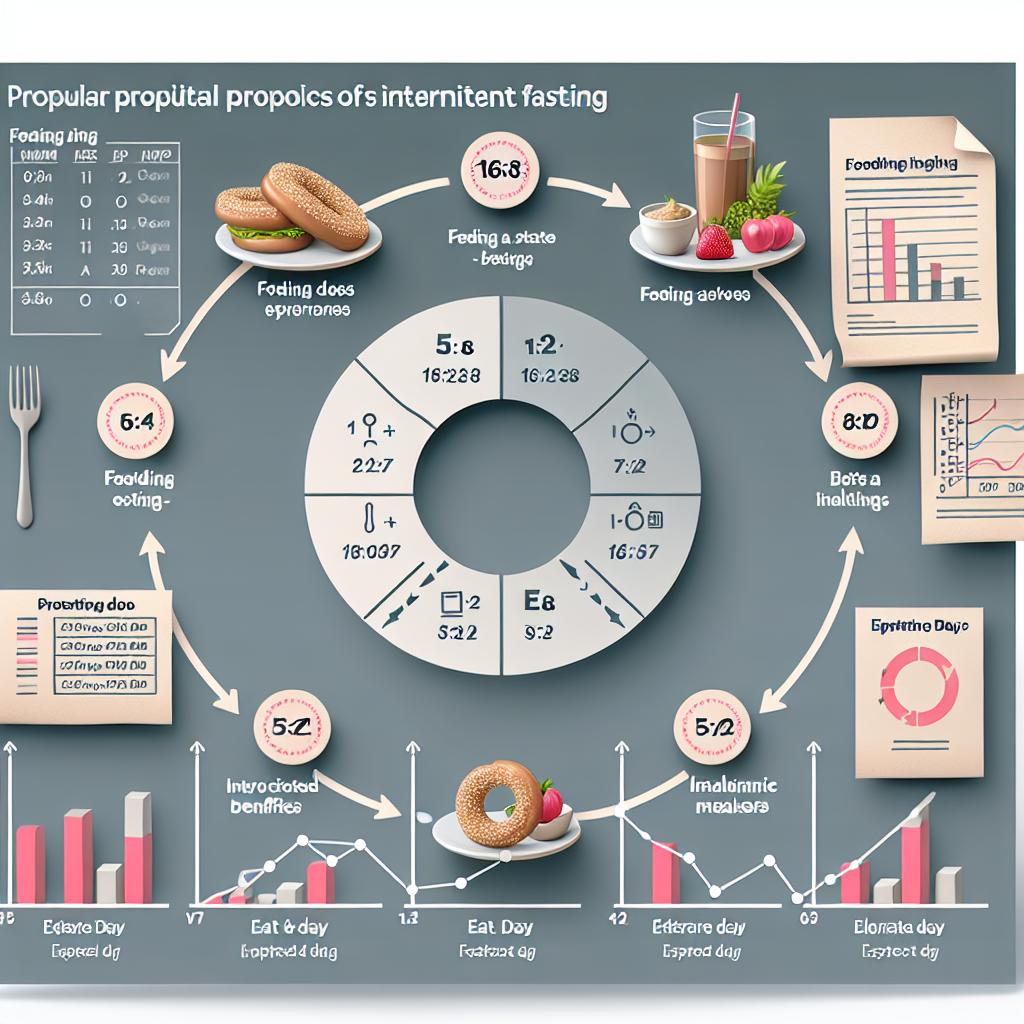
“Fasting Fundamentals: Understanding Its Meaning”
Fasting—an age-old practice steeped in cultural and spiritual tradition—has found its resurgence in the modern wellness narrative, revealing an intricate tapestry of implications for human health. Touted by some for its potential benefits ranging from improved metabolic health to enhanced cognitive function, the act of abstention from food and drink for specified periods of time has intrigued scientists and health enthusiasts alike. But beyond the buzz lies a complex physiological landscape that demands a meticulous understanding. In this deep dive into the fundamentals of fasting, we peel back the layers of this ancient regimen to uncover the science behind its meaning, the myriad forms it takes, and the mechanisms through which it can impact an individual’s well-being. Join us as we sift through the empirical evidence and explore the nuances of this time-honored tradition turned modern health phenomenon, offering readers a grounded perspective on fasting’s place in contemporary health discourse.
Table of Contents
- Exploring the Historical Roots of Fasting Practices
- Defining Fasting: More Than Just Abstinence from Food
- Types of Fasts: Religious, Health, and Lifestyle Variations
- The Science Behind Fasting: What Happens in Your Body
- Fasting for Weight Loss: Myth or Reality?
- Intermittent Fasting: Popular Protocols and Their Effectiveness
- Pre-Fasting Considerations: Assessing Your Health and Goals
- Navigating the Challenges and Side Effects of Fasting
- Post-Fasting: Safely Reintroducing Foods and Maintaining Benefits
- Embracing Fasting as a Holistic Practice for Mind and Body
- Q&A
- In Conclusion
Exploring the Historical Roots of Fasting Practices

Travel back in time, and you’ll discover that the ritual of fasting holds a prominent place in the tapestry of history. It is not merely a modern health trend but is deeply rooted in various cultural, religious, and traditional practices across the globe. From ancient philosophers to religious texts, fasting has been a testament to humanity’s search for physical and spiritual well-being.
Ancient Beginnings: The Greek philosopher Hippocrates, considered the father of Western medicine, prescribed fasting as a potent cure for certain illnesses. His teachings influenced many, championing the idea that periodic abstinence from food could cleanse the body and revitalize the mind. Similarly, Plato and Aristotle documented their commitment to fasting, highlighting its benefits for mental clarity.
- Judaism: Yom Kippur, the Day of Atonement, is observed by refraining from food and drink for 25 hours.
- Christianity: Lent is a period of 40 days of fasting, representing Jesus Christ’s time in the wilderness.
- Islam: During the holy month of Ramadan, Muslims fast from dawn until dusk, a practice that teaches self-control and compassion.
- Buddhism: Monks and nuns often adhere to intermittent fasting, avoiding food after the midday meal to maintain mindfulness and discipline.
Cultural connections are just as vibrant. Many indigenous tribes have historically used fasting as a rite of passage or for medicinal purposes. They believed that fasting could purify the soul and bring one closer to the spiritual forces of the universe. Whether for healing, clarity, or spiritual awakening, these practices share a common recognition of fasting’s transformative power.
| Civilization | Purpose of Fasting | Frequency |
|---|---|---|
| Ancient Egyptians | Ritual purity | Seasonal |
| Aztecs | Spiritual cleansing | Before significant events |
| Ancient India | Physical and spiritual health | During specific lunar cycles |
In each instance, the common thread weaves a story of renewal – a humbling and purposeful retreat from the everyday indulgence of food. The fast becomes a silence filled with contemplation, a space where the noise of consumption is quieted, and introspection takes the center stage. Drawing on such historical roots, contemporary fasting continues to evolve, reflecting the diverse perspectives and practices of societies ancient and current.
Defining Fasting: More Than Just Abstinence from Food

Fasting has long been shrouded in a veil of simplicity – it’s seen merely as avoiding food for a period of time. However, this practice spans a broader spectrum, encompassing physical, mental, and spiritual dimensions. Engaging in a fast extends beyond the mere absence of meals; it’s an act that challenges the individual to confront habitual patterns and often to engage in a period of self-reflection and personal development.
At its core, fasting represents a conscious choice to forego nourishment to achieve a specific goal. This goal is not always weight loss or health-related. For many, it is a time-honored tradition tied to cultural or religious observances. For others, it might be a form of protest or a way to demonstrate conviction. The act of withholding food, then, becomes a symbol, a gesture loaded with intention and meaning.
Intriguingly, the practice takes on numerous forms, adapted to the objectives and beliefs of the person embarking on the journey. Consider:
- Intermittent Fasting: Daily cycles of eating within a particular timeframe.
- Time-Restricted Feeding: Aligning the eating schedule with circadian rhythms.
- Caloric Restriction: Reducing daily calorie intake without specific fasting periods.
Each method tailors the fasting experience to individual needs, blurring the lines between what is traditionally understood as fasting and modern dietary practices.
| Type of Fasting | Duration | Purpose |
|---|---|---|
| 24-Hour Fast | 1 Day | Detoxification, Mental Clarity |
| Daniel Fast | 21 Days | Spiritual Enlightenment |
| Alternate-Day Fasting | Variable | Longevity, Heart Health |
Understanding fasting in its multifaceted aspects requires an appreciation of its nuances. Whichever form it takes, fasting calls for a degree of discipline and introspection. It’s a personal voyage that transcends the simple act of not eating, as it touches the very essence of human willpower and the profound search for meaning – be it in the frame of one’s health, spiritual journey, or ethical stance.
Types of Fasts: Religious, Health, and Lifestyle Variations

Throughout history and across various cultures, fasting has served as a common thread, embodying spiritual, health, and lifestyle practices. Religious fasting is steeped in tradition, with each faith prescribing its own purpose and guidelines. For instance, Muslims observe Ramadan, a month-long period of fasting from dawn until sunset, while Christians may fast during Lent, a time of reflection leading up to Easter. These fasts are often characterized by abstention from food and drink for specific time frames, with the intent of spiritual renewal and adherence to religious precepts.
- Yom Kippur: A Jewish day of atonement that typically involves a 25-hour fasting period.
- Navaratri: Hindus may fast during this nine-day festival, often abstaining from grains, onions, and garlic.
- Lent: Some Christians abstain from certain foods or meals for the 40-day period.
On the wellness spectrum, health-oriented fasts are implemented with a focus on physical benefits, such as improved digestion, weight loss, and detoxification. These include time-restricted eating, such as the 16/8 method that boasts 16 hours of fasting and an 8-hour eating window. Another is the 5:2 diet, where caloric intake is reduced for two non-consecutive days each week, offering a form of intermittent fasting that many find more manageable.
Moving away from the more conventional reasons for fasting, lifestyle variations have emerged, often blending health and personal well-being. This might include the occasional voluntary abstinence from social media or digital devices, known as a digital detox. While not involving food, this type of fast is intended to cleanse the mind and improve social and personal relationships by reducing distractions and fostering presence in the moment.
Finally, no matter the type of fast, it is vital to consider personal health and circumstances before starting. Consulting with a healthcare provider can ensure safety, particularly for those with pre-existing conditions. As the reasons and methods for fasting are as varied as the individuals practicing them, one size does not fit all. It’s critical to tailor your fasting approach to fit your specific health needs, beliefs, and lifestyle choices.
The Science Behind Fasting: What Happens in Your Body

Embarking on a fast initiates a fascinating biological journey as your body transitions from its fed state, harnessing glucose for energy, to a fasting state where it looks to alternative energy sources. The metabolic switch is thrown usually between 12 to 36 hours after your last meal, sending your body into the realms of so-called ‘starvation mode’ that, paradoxically, can bolster overall health.
- Glycogen Depletion: With no incoming food supply, the body depletes its glycogen reserves, the stored form of glucose found in the liver and muscles. This stage is critical for weight loss as the depletion of glycogen forces the body to burn fat for fuel.
- Increase in Autophagy: This process is the body’s way of cleaning out damaged cells, in order to regenerate newer, healthier cells. During fasting, autophagy rates are significantly upregulated, potentially lowering the risk of many diseases.
- Insulin Sensitivity Improvement: Without the regular spikes in blood sugar from eating, insulin levels lower, making body cells more responsive to it. This improved sensitivity can be protective against type 2 diabetes and facilitate controlled blood sugar levels.
- Hormonal Adjustments: Levels of norepinephrine and growth hormone rise, aiding in fat loss and muscle preservation. Contrary to popular belief, short-term fasting may actually increase metabolic rate, thanks to these hormonal shifts.
Let’s take a peek at how hormonal levels fluctuate following a fasting period, as shown in this simplified table:
| Hormone | Change During Fasting |
|---|---|
| Insulin | Decreases |
| Growth Hormone | Increases |
| Norepinephrine | Increases |
These biological changes showcase the body’s remarkable ability to adapt to periods without food. After the 36-hour mark, fatty acids called ketones become the primary energy source as the body enters ketosis. Ketones are not only a cleaner burning fuel for the body but also have neurological benefits, being linked to improved brain function and potential protective effects against neurodegenerative diseases.
Though often championed for its weight loss potential, fasting’s real charm lies in its cellular and hormonal impacts. By understanding its scientifically-backed processes, we’re better positioned to harness fasting for its wide range of health benefits and integrate it responsibly into our health regimen.
Fasting for Weight Loss: Myth or Reality?

The debate surrounding the efficacy of fasting as a weight loss strategy has been filled with polarizing opinions. On one hand, proponents argue that fasting – specifically, the process of voluntarily abstaining from some or all food, drink, or both, for a set period – can initiate several metabolic processes that contribute to weight loss. However, it’s essential to dissect the available evidence to distinguish fact from well-perpetuated fiction.
Scientific Underpinnings: At the heart of the weight loss conversation is the body’s metabolic switch from glucose-based to ketone-based energy, which occurs during prolonged periods without food. This shift, known as ketosis, is cited as a key player in the weight loss that many experience while fasting. Studies have shown that fasting can improve metabolic efficiency and reduce calorie intake, but the outcomes vary among individuals based on factors like age, sex, and lifestyle.
- Balancing Act: Fasting isn’t a one-size-fits-all solution. When poorly managed, it can lead to muscle loss alongside fat loss, a scenario that is counterproductive for overall health and metabolism. Muscle mass is crucial for a healthy metabolic rate; hence, balance is key.
- Nutrient Sufficiency: Fasting periods must be strategically planned to ensure that nutritional needs are met. Prolonged fasting without proper refeeding can lead to nutrient deficiencies, potentially causing more harm than good.
- Mindful Eating Habits: Fasting can encourage a more mindful approach to eating, leading to healthier food choices and better portion control which, in turn, supports weight loss.
| Fasting Type | Duration | Weight Loss Potential | Risks and Considerations |
|---|---|---|---|
| Intermittent Fasting | 16-24 hours | Moderate | Overeating post-fast |
| Alternate Day Fasting | 36 hours | High | Nutrient intake monitoring |
| Extended Fasting | 48 hours + | Varied | Requires medical supervision |
Ultimately, approaching fasting for weight loss necessitates an understanding of both the scientific principles underlying it and the individual’s unique physiological and psychological responses to food restriction. While there is evidence supporting fasting as a tool for weight management, it is critical to engage with these practices under expert guidance to ensure that they are safe, suitable, and beneficial in the long term. In other words, fasting can be both a myth and a reality for weight loss; it all depends on execution and context.
Intermittent Fasting: Popular Protocols and Their Effectiveness

Exploring the landscape of fasting protocols can be akin to navigating a vast nutrition maze, each path promising a shortcut to wellness. Among the plethora of strategies, several have risen to prominence, each with unique timelines and rules that cater to different lifestyles and goals.
16/8 Method: Arguably the frontrunner of fasting methods, this protocol carves out an eight-hour window for consuming all daily calories. Ideal for those who prefer not to disrupt their social eating habits, it typically involves skipping breakfast and consuming a late lunch as the first meal. Proponents report this method’s effectiveness for weight management, improved insulin sensitivity, and potential longevity benefits.
- Eating Window: 12pm – 8pm
- Fasting Window: 16 hours
- Suitability: Beginners to intermediate fasters
5:2 Approach: This flexible regimen involves normal eating for five days of the week, interspersed with two non-consecutive days of significant calorie reduction. It’s a less grueling introduction to fasting and has been championed for not only encouraging weight loss but also for its cardiovascular and brain health implications. Users typically restrict intake to 500-600 calories on their fasting days.
| Day | Normal Intake | Restricted Intake (Calories) |
|---|---|---|
| Monday | Yes | — |
| Tuesday | No | 500-600 |
| Wednesday | Yes | — |
Eat-Stop-Eat: For those seeking to dive deeper into the fasting pool, this protocol suggests a complete 24-hour fast once or twice a week. Embarking on this journey from dinner-to-dinner or lunch-to-lunch allows individuals to experience the full metabolic switchover to fat burning without the commitment of a daily routine. Studies suggest benefits such as improved blood glucose control and a reduction in inflammation markers.
- Full 24-hour fast once or twice a week
- Evidence of metabolic benefits
- Requires a moderate level of fasting experience
Alternate Day Fasting: Taking the concept a step further, this entails a day of normal eating followed by a day of either complete fasting or limited caloric intake (around 25% of normal daily calories). While it’s a more advanced form of fasting, aficionados swear by its ability to significantly improve fat loss and promote autophagy, the body’s natural process of cleaning out damaged cells.
While each method has garnered a community of followers, the effectiveness of these protocols varies from person to person. Factors such as lifestyle compatibility, personal health goals, and even genetic predispositions play a significant role in shaping the fasting experience. It’s advisable to consult with a healthcare provider before embarking on a fasting journey.
Pre-Fasting Considerations: Assessing Your Health and Goals

Before embarking on a fasting journey, it’s crucial to take a reflective pause and honestly evaluate your physical condition and the intentions behind your decision to fast. This is not just about marking a checkbox; it’s about ensuring that you are setting yourself up for a safe and rewarding experience.
Health Status: Your current health status is a cornerstone of consideration. If you have chronic conditions such as diabetes, hypertension, or heart issues, fasting may require special precautions or medical supervision. Are you currently taking any medication? Could fasting interfere with its efficacy? Compile these inquiries and consult with a healthcare provider. Here’s a simple checklist to help you gather your thoughts:
- Underlying health conditions
- Medications and supplements currently taken
- Previous experiences with fasting
- Potential risks specific to your health profile
Define Your Objectives: Are you fasting for weight loss, to enhance mental clarity, or perhaps for spiritual reasons? Aligning your fasting method with your goals is pivotal. For example, intermittent fasting might align better with weight management, while extended fasts might facilitate deeper self-reflection.
| Goal | Recommended Fasting Type |
|---|---|
| Weight Management | Intermittent Fasting (16/8 method) |
| Mental Clarity | Short-term Fasts (24 hours) |
| Spiritual Reflection | Extended Fasts (3 days or more) |
Preparation is Key: Gradually reducing your intake of food, especially heavy or rich foods, can help ease your body into the fasting experience. Start by opting for lighter meals that are rich in nutrients but low in processed sugars and fats. Consider hydrating more robustly than you typically would. To anchor yourself, it may be helpful to keep a pre-fasting diary to track your meals and how your body feels leading up to the fast.
Finally, consider the timing of your fast. Aligning it with a period when stressors are at their ebb, and where you can maintain a calm environment, will likely enhance the quality of your fasting experience. Are your work demands currently high? Do you have family commitments that require energy and focus? Scheduling your fast for times when these demands are lower can be beneficial.
By thoughtfully evaluating these factors, a would-be faster can lay the groundwork for a more effective and profound fasting experience. Remember, the goal is to grow and benefit from the journey – not just endure it.
Navigating the Challenges and Side Effects of Fasting

If you’re exploring the world of fasting, it’s essential to recognize that while the practice can offer numerous health benefits, it also comes with its own set of challenges and side effects. The body reacts to the absence of food in ways that can sometimes be uncomfortable, but understanding these responses is key to navigating your fasting journey successfully.
Initial Side Effects: When beginning a fasting regimen, especially for first-timers, you may encounter a few common side effects. These can include headaches, fatigue, and irritability, often emerging as your body transitions from glucose to fat stores for energy. Digestive issues such as bloating or constipation may also surface, stemming from changes in your eating pattern. Ensuring proper hydration and electrolyte balance can mitigate some of these discomforts.
- Mild headaches
- Energy dips
- Mood fluctuations
- Changes in bowel habits
Maintaining Nutritional Balance: A critical aspect to consider is the nutritional intake during non-fasting periods. This means prioritizing nutrient-dense, whole foods that provide essential vitamins and minerals to support bodily functions. Ignoring these needs can lead to more severe side effects such as muscle weakness, dizziness, or nutrient deficiencies.
| Essential Nutrient | Food Sources |
|---|---|
| Protein | Legumes, lean meats, nuts |
| Fiber | Fruits, vegetables, whole grains |
| Calcium | Dairy products, fortified plant milk, leafy greens |
| Iron | Red meat, beans, fortified cereals |
Overcoming Psychological Hurdles: The mental and emotional challenges that accompany fasting are not to be underestimated. The trick is to develop a strong mindset—view fasting as a positive step towards health rather than a restriction. For many, the incorporation of mindfulness strategies and establishing solid support systems are game-changers in staying the course with their fasting protocol.
In conclusion, by heading into your fasting journey with eyes wide open to the potential challenges and with strategies to manage side effects, you’re setting the stage for a more positive and sustainable fasting experience. Consider these pointers as your roadmap through the fasting landscape, ultimately guiding you towards your health and wellness destination.
Post-Fasting: Safely Reintroducing Foods and Maintaining Benefits

Emerging from a fasting period requires a thoughtful approach to reactivate your digestive system without overwhelming it. The transition should be gradual, starting with easily digestible foods and slowly reintroducing solids to your diet. It’s vital to heed to your body’s response during this time to maximize the benefits you’ve gained from fasting.
Begin with **broth and juices**, which provide essential nutrients without taxing the digestive system. These can include:
– Homemade vegetable broth, rich in minerals
– Fruit juices diluted with water (to reduce sugar intake)
– Bone broth, which offers protein and minerals
Ensure that these liquids are at a comfortable temperature; extreme hot or cold can cause stomach discomfort after a period of fasting.
With your system now primed for more substantial fare, steer towards foods that are kind to your digestion. Soft fruits like bananas and avocados are excellent choices, as are cooked vegetables. These provide fibers and vitamins while being gentle on the stomach. Be mindful of portion sizes—small, frequent meals can be more manageable than large, infrequent ones. This is the perfect stage to start blending **healthy eating habits** with your post-fasting diet:
– Soft-cooked carrots, an easy-to-digest option rich in vitamin A
– Applesauce, a source of fruit fiber without the harshness of raw skins
– Oatmeal, offering comforting soluble fiber which can aid in digestion
After these initial forays back into solid food, it’s time to gradually add in protein and fat. These are vital for rebuilding tissues and sustaining energy levels. However, they can be taxing on a still-recovering digestive system if introduced too quickly. Opt for lean proteins and healthy fats, such as:
– Poached or boiled eggs
– Plain Greek yogurt
– Grilled fish
– Avocado and olive oil (for their healthy fats)
| Food Type | Suggestions | Notes |
|---|---|---|
| Protein | Grilled Chicken, Lentils | Lean, Easy to Digest |
| Fats | Nuts, Seeds | Nutrient Dense |
| Complex Carbs | Sweet Potatoes, Brown Rice | Slow Energy Release |
Completing the refeeding process by introducing complex carbohydrates can help maintain the benefits of fasting, like sustained energy and stable blood sugar levels. Foods such as quinoa, sweet potatoes, and brown rice are excellent sources. They provide the body with fiber to continue healthy digestion and nutrients for overall well-being. Pay attention to your body’s signals, and don’t hesitate to adjust your food intake based on your personal needs. The post-fasting phase is not only about reintroducing food but also about nurturing a sustainable, balanced diet that carries you forward with vitality and health.
Embracing Fasting as a Holistic Practice for Mind and Body

Fasting, often understood simply as the abstinence from food or drink, is not merely a dieting fad or a momentary deprivation. It is an age-old practice rooted in various traditions, cultures, and religions, often associated with purification, self-discipline, and heightened awareness.
Health Benefits Galore
When adopted with mindfulness, fasting can bring an array of health benefits. Research suggests that strategic fasting may promote:
- Autophagy, the body’s process of cleaning out damaged cells, to potentially reduce the risk of several diseases.
- Improved metabolic health by optimizing blood sugar control and increasing resistance to stress.
- Enhanced brain health through the promotion of neurogenesis and protection against neurodegenerative diseases.
- Longevity, by influencing pathways that affect lifespan and healthspan.
But beyond the physical, fasting transcends into the mind, encouraging a deeper connection with one’s own thoughts and feelings. It often leads practitioners to a state of mental clarity and focus, potentially reducing anxiety and fostering a sense of inner peace.
Cultural and Spiritual Significance
The practice is profoundly integrated into the fabric of spiritual disciplines worldwide. Here’s a glance at how different cultures and religions embrace fasting:
| Spiritual Tradition | Purpose of Fasting |
|---|---|
| Buddhism | Detachment from physical needs, cultivating self-control and mindfulness. |
| Christianity | Repentance, reflection, and preparation for holy days. |
| Islam | Self-purification, empathy for the less fortunate, and spiritual renewal during Ramadan. |
| Judaism | Introspection and atonement, especially during Yom Kippur. |
| Hinduism | Enhancing concentration, devotion, and expression of gratitude. |
Each of these reveal fasting as a multifaceted practice — not just to abstain from food but as a gesture of devotion, self-control, and an opportunity for existential reflection.
Approaching Fasting Mindfully
Despite the potential benefits, fasting isn’t a one-size-fits-all regimen. With mindfulness comes the acknowledgment that every individual’s body and circumstances are unique. Before beginning a fasting journey, consider the following steps:
- Consult with a healthcare provider to ensure it’s safe and appropriate for your health condition.
- Start gradually; initiate the practice with shorter fasting periods to allow your body to adapt.
- Stay hydrated and be aware of the body’s signals to prevent dehydration and nutrient deficiencies.
- Reflect on the purpose of your fast; whether for health, spiritual growth, or both, keep your intentions clear.
By ensuring that the approach to fasting is grounded in personal well-being and mindfulness, it stands to amplify the potential benefits and provide a holistic boost to both mind and body.
Q&A
### Fasting Fundamentals: Understanding Its Meaning – Q&A
**Q1: What exactly is fasting, and how is it typically practiced?**
Fasting is the deliberate abstinence from all or some kinds of food or drink for a set period. While practices vary widely among cultures, religions, and individuals, common types of fasting include intermittent fasting (cycling between periods of eating and abstaining), caloric restriction, water fasting (consuming water only), and religious fasts (which often have specific guidelines and timings).
**Q2: Are there different categories of fasting? If so, what are they?**
Yes, fasting can be categorized in several ways. Time-restricted fasting involves eating within a certain window each day, while periodic fasting refers to abstaining for longer periods, such as 24-48 hours, or even several days. Alternate-day fasting is as it sounds, eating one day and fasting the next. There’s also the Daniel Fast, a biblically-inspired regimen focusing on plant-based foods, and fasting mimicking diets, which aim to achieve the benefits of a fast while still providing some level of nourishment.
**Q3: Can fasting have health benefits?**
Research suggests that fasting can offer an array of health benefits, including weight loss, improved metabolic health, enhanced brain function, and a potential decrease in the risk factors for diseases such as diabetes and heart disease. It appears that fasting may help to reset certain bodily processes and can lead to increased cellular repair.
**Q4: What are some of the risks associated with fasting?**
Fasting, especially if done improperly or for prolonged periods, can lead to nutrient deficiencies, dehydration, muscle loss, and can exacerbate certain health conditions like diabetes. Some people may experience negative side effects like fatigue, headaches, or mood swings. It’s essential to consult a healthcare provider before starting any type of fast.
**Q5: How do religious and cultural perspectives influence fasting practices?**
Fasting has deep roots in many religions and cultures, often associated with purification, meditation, or penance. For example, Muslims observe Ramadan, a month of fasting during daylight hours, while Christians may fast during Lent. Jewish people observe Yom Kippur with a 25-hour fast. In many cultures, fasting is not just about physical health but is a way to express faith, discipline, and community.
**Q6: Is fasting suitable for everyone?**
No, fasting isn’t appropriate for everyone. Children, pregnant or breastfeeding women, individuals with eating disorders, those who are underweight, or anyone with certain health conditions should not fast. It’s important that each person considers their own health status and consults with a healthcare professional before embarking on a fasting regimen.
**Q7: How does one prepare for a fast safely?**
To prepare for a fast safely, it’s recommended to gradually reduce food intake and focus on high-nutrient foods leading up to the fast. Staying hydrated is crucial, and individuals should plan for a period of rest and reduced physical activity during the fast. After the fast, reintroduction of food should be gradual to prevent gastrointestinal distress.
**Q8: Does fasting have an impact on mental well-being?**
Fasting can have varying effects on mental well-being. Some report heightened mental clarity and emotional resilience, while others may experience irritability or anxiety. The impact on mental health largely depends on the individual’s physical response to fasting, the type of fast, and psychological factors such as one’s understanding and purpose for fasting.
**Q9: Can fasting be integrated with exercise routines?**
While light to moderate exercise may be okay for some people during short fasting periods, intense exercise isn’t usually recommended due to potential energy depletion. Listening to the body’s signals is vital, and it’s best to consult with a healthcare professional or a fitness expert to develop a plan that incorporates fasting with exercise safely.
**Q10: Where can people find reliable information and guidance on fasting?**
Reliable information and guidance on fasting can be found through scholarly articles, certified health and nutritional experts, and academic institutions that conduct research on diet and health. It’s critical to seek information from credible sources and be wary of unfounded health claims or extreme fasting protocols promoted by unreliable sources.
In Conclusion
As we close this investigative journey through the multifaceted realm of fasting, it’s evident that its significance extends far beyond mere dietary choice or fleeting health trend. Fasting’s deep historical and cultural roots, as well as its potential for profound physiological impacts, underscore its enduring relevance. The confluence of scientific inquiry and personal testimony has revealed a wealth of benefits and considerations, framing fasting not just as a practice but as a dimension of wellness that beckons further exploration and respect.
As with any substantive change to one’s lifestyle, the pursuit of fasting should be approached with judicious consideration, balancing research with individual health contexts. The dance between scientific validation and personal experience continues to shape our collective understanding of fasting, inviting each person to a unique encounter with this age-old tradition.
While today’s article provides a foundational understanding of fasting, the conversation is far from over. Engage with medical professionals, immerse yourself in ongoing research, and, if you choose to embark on this journey, monitor your health closely. Remember, the pathway to well-being is as individual as the myriad of cells that comprise the human body. As we continue to unlock the mysteries behind fasting, its wisdom remains a testament to the interconnectedness of body, mind, and the rhythms of nature.
























